Frost susceptibility of soils―A confusing concept that can misguide geotechnical design in cold regions
DaiChao Sheng
1.School of Civil&Environmental Engineering,University of Technology Sydney,Sydney Australia
2.National Engineering Laboratory for High‐Speed Railway Construction,Central South University,Changsha,Hunan 430074,China
ABSTRACT Frost susceptibility is a concept widely used in cold region geotechnical design,to quantify the capacity of a soil in generat‐ing frost heave and frost damage.The laboratory test used to verify frost susceptibility of a soil is based on the measurement of frost heave generated in the soil under specific conditions.Ⅰn reality this concept is,however,more related to the soil's po‐tential to thaw weakening than to frost heave.Recent experimental studies show that frost non‐susceptible soils like clean sand and clean gavel can also generate much ice segregation and frost heave if the conditions are favourable,hence chal‐lenging the usefulness and suitability of soil classification based on frost susceptibility.Ⅰt is further shown that the concept is not suitable for design scenarios where frost heave itself is a serious hazard,such as in high‐speed rail embankments.
Keywords:frost susceptibility;frost heave;thaw weakening;high‐speed rail
1 Soil frost susceptibility
Ⅰn cold region geotechnics,soils are usually classi‐fied into different groups of frost susceptibility.A frost susceptible soil is considered to generate signifi‐cant frost heave when frozen and hence leads to frost damage if not controlled,whereas a frost non‐suscep‐tible soil is not expected to generate much heave and can be used as frost damage prevention material.There are a number of classification criteria in the lit‐erature(Beskow,1935;Chamberlain,1981;Konrad,1999;Shenget al.,2013;Carter and Bentley,2016),and a key factor used in all classifications is the fine content.For example,in Sweden,soils are classified into three groups:Ⅰ,ⅠⅠandⅠⅠⅠ(BYA84,cited in Sheng,1994),with GroupⅠⅠⅠbeing most and GroupⅠleast susceptible to frost heave.GroupⅠsoils are coarse grained soils like sand,while GroupⅠⅠare typi‐cal clayey soils.GroupⅠⅠⅠsoils are typically interme‐diate soils like silt.Ⅰn China,the filling materials used in railway embankment are classified into four groups:non‐susceptible,weakly susceptible,suscepti‐ble and strongly susceptible to frost heave(Yeet al.,2007;Liuet al.,2011),based on fine content of a soil.The Chinese railway classification is usually used in conjunction with the three groups of embankment fills:A,B and C,with Group A fill being not suscepti‐ble to frost heave,and Group C strongly susceptible to frost heave.The frost susceptibility of Group B fill depends on its fine content(Liuet al.,2011)or its ini‐tial water content(Yeet al.,2007).
The frost susceptibility of a soil is usually verified in laboratory test.Chamberlain(1981)presented such a test setup as shown in Figure 1.While the specific setup and testing procedure may vary from country to country and from standard to standard,some common features apply to this type of tests:

Figure 1 Frost susceptibility test(after Chamberlain,1981)
1.Temperatures at the ends of the specimen are controlled,with one end subjected to sub‐freezing temperature.
2.A load is applied at the top of specimen.
3.The soil specimen is placed above the water ta‐ble and has access to external liquid water supply.
4.Measured frost heave during a freezing period is used to determine the frost susceptibility.
Because frost heave,not frost damage,is used to define soil's frost susceptibility,it is interesting to note that the term itself is translated to"frost heave susceptibility"in some languages like Chinese.
Ⅰt is also interesting to note that the specimen is placed above the water level and has a unique way of accessing external water:it has access only to liquid water,not any other form of water.This is a crucial condition for such a test.Ⅰf this condition is not satis‐fied,the frost susceptibility of the tested soil can not be verified.
Since Beskow(1935),we have come to accept that coarse soils like clean sand and gravel are not frost susceptible and does not lead to much frost dam‐age when frozen.This type of soil has very low water retention capacity,does not develop significant suc‐tion to suck the water up to the freezing front.On the other hand,clays are usually considered less frost sus‐ceptible because of their small permeability.Unless the cooling rate is very small and freezing period is sufficiently long,water flow is not sufficiently fast to feed the ice formation in the soil.Only the intermedi‐ate soils like silt that have a reasonable permeability as well a reasonable water retention capacity are con‐sidered to be frost susceptible.Sandy soils that have significant fine content or clayey soils that have a good permeability can also become frost susceptible.
The above understanding has guided much of cur‐rent engineering practice in cold regions.For exam‐ple,shallow silty soils are replaced by sand or gravel to reduce frost damage.Frost non‐susceptible soils are used as frost prevention layers in road and railroad em‐bankments.The current design criterion for high‐speed rail embankment in cold regions in China is very much based on the frost susceptibility classification.Frost prevention layers in such an embankment are essential‐ly Group A or B fills with strict control of fine con‐tents.Group A differs from Group B or C fill is also largely because of its strict limit of fine content.
However,some recent engineering problems and recent research results seriously challenge our under‐standing of soil frost susceptibility.This paper will discuss some pitfalls in the use of the concept in engi‐neering practice.The paper is organised in as follows.Ⅰt discusses a number of key questions:does a frost non‐susceptible soil generate frost heave?Why has the frost susceptibility classification largely worked so far?When does such a classification will not work and what are the possible alternative design criteria?By answering these key questions,the author hopes to shed some lights on the suitability and limitations of soil classification based on frost susceptibility.
2 Does a frost non-susceptible soil generate frost heave in reality?
Because frost susceptibility is based on frost heave experiments under controlled conditions,a weakly frost susceptible soil is not expected to generate much heave.However,recent research outcomes have seri‐ously challenged such an expectation.
Motivated by observed frost heave in coarse lay‐ers in high‐speed rail embankments(Shenget al.,2014;Zhanget al.,2016b),Tenget al.(2019)recent‐ly tested a clean sand in a one‐dimensional freezing test.The clean sand has zero content of particles finer than 0.075 mm.Ⅰndeed all particles fall within the size range of 0.5−1.0 mm.Ⅰts initial water content ranges from zero to 10%by weight.The freezing test is very much the same as that by Chamberlain(1981,Figure 1),except that the lower end of the specimen was not connected to liquid water supply,but had ac‐cess to vapour.The upper end of the specimen was completely sealed against drainage or evaporation.Ⅰt was observed that significant ice formed within the upper frozen part of the specimen,including the inter‐face between the specimen and top plate(Figure 2).This ice formation occurred in the specimen for all three initial water contents:0%,5%,10%.The water content shown in Figure 2 is the total water content that includes ice content.The accumulation of ice at the top end attributes to the large water content there.Frost heave was not allowed in the test as the top plate was fixed.However,Tenget al.(2020)revised their test in a follow‐up study and reported frost heave for a similar test.
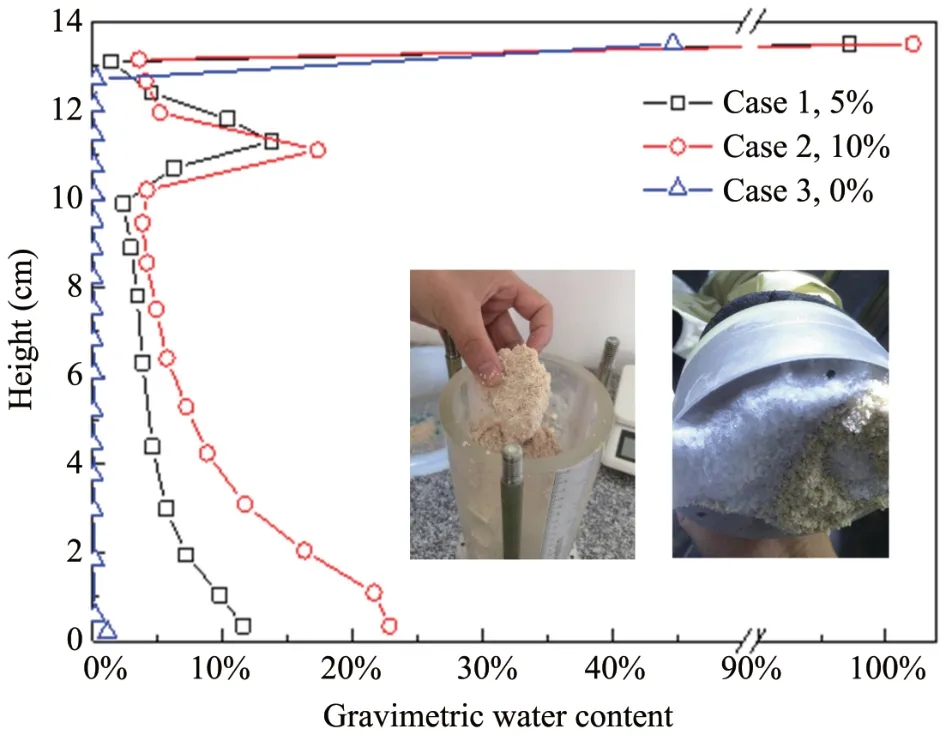
Figure 2 Moisture migration and ice segregation in clean sand(after Teng et al.,2019)
Baiet al.(2018)presented similar experimental re‐sults on a gravel.The gravel was first cleaned by re‐moving all particles finer than 0.5 mm and larger than 2 mm.A 10%(by mass)silty clay was then mixed with the gravel.The initial water content was set to 10%by volume.The 20 cm long specimen was then frozen from top downwards for 96 hours,with constant tem‐peratures applied at both ends.Figure 3 shows a signifi‐cant increase in total water content near the upper end,due to ice formation there.Some frost heave was re‐corded as well during the test.The authors attributed the water redistribution and ice formation in the speci‐men to combined vapour and liquid water transfer.
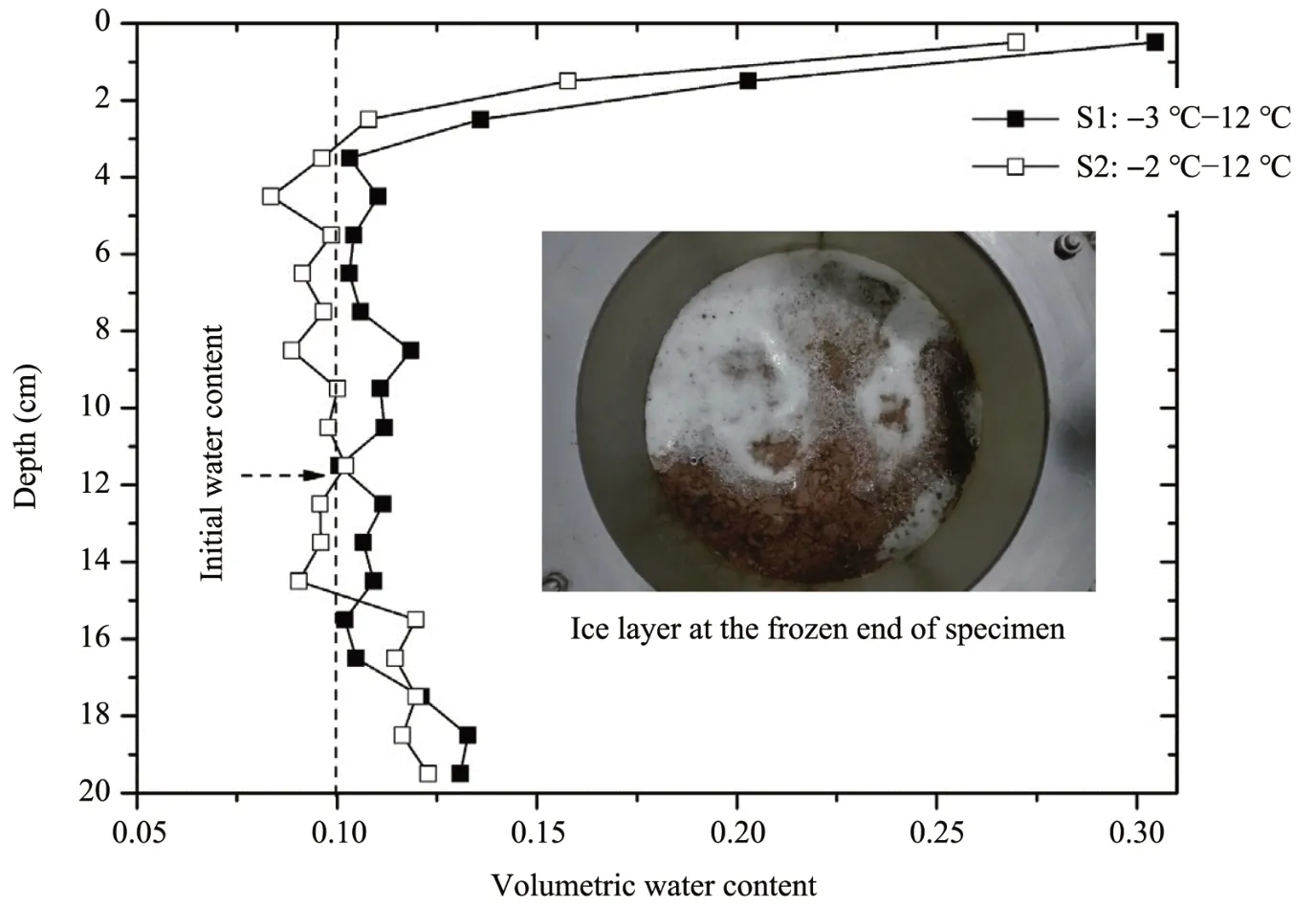
Figure 3 Moisture migration in gravel after 96 hours of freezing(after Bai et al.,2018)
Zhanget al.(2019)tested a coarse grained soil taken from a high‐speed rail embankment in north‐eastern China.The soil is finely angled gravel with 50%soil particles larger than 2 mm and 10%particles smaller than 0.1 mm.A 20 cm long specimen was sub‐jected to−10°C at its top end and 5°C at its lower end,for 48 hours.Ⅰn their tests,they studied the case where a porous steel plate was placed at the bottom of the specimen to stop liquid water migration into the specimen,and compared it with the case without the porous stone(water separation layer).They used dis‐solved fluorescein tracer and image‐processing tech‐nology were used,to observe the evolution process of the liquid and vapour migration in the specimen.Fig‐ure 4 shows a set of their test results where they com‐pared the cases with and without liquid water migra‐tion.Ⅰt is interesting to note that the initially dry speci‐men having no access to liquid water has accumulated significant water in the freezing soil,via vapour mi‐gration only.Figure 4b shows approximately 90%of external water intake is due to vapour flow.
The soils tested by Tenget al.(2019),Baiet al.(2018)and Zhanget al.(2019)are all coarse materi‐als that were considered to be not frost susceptible.Their particle size distributions(PSD)are shown in Figure 5.According to their PSDs,these materials would be considered ideal for preventing frost heave and frost damage.Because of their low fine contents(<10%),their water retention capacity would be low and would not test positive in standard frost heave or frost susceptibility tests.The only difference between their tests and the standard frost heave test is to allow the specimen have access to vapour supply.
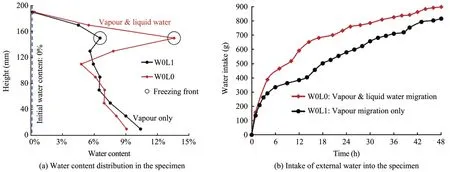
Figure 4 Moisture migration in gravel after 48 hours of freezing(after Zhang et al.,2019)
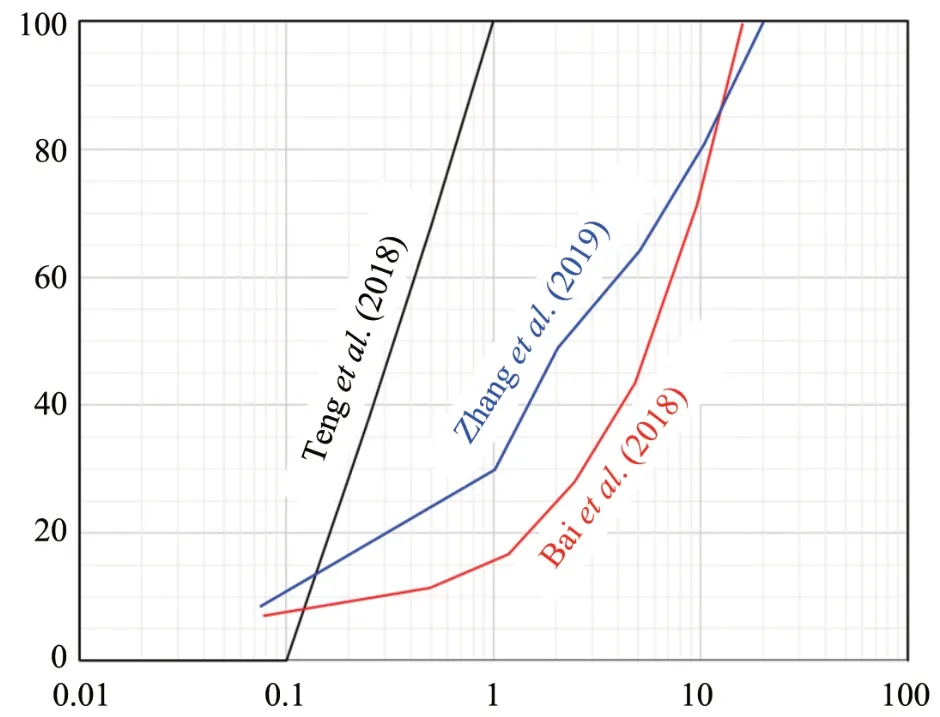
Figure 5 Particle size distributions of tested soils
Vapour flow is seldom considered in current geo‐technical design.When the ground surface freezes in winter,the soil above the capillary zone may not have access to liquid water.Ⅰn dry coarse grained soils like gravel and clean sand,it is very difficult for liquid wa‐ter to flow to the freezing front to feed the ice forma‐tion there.However,vapour always exists above the groundwater table,and a temperature gradient will fa‐cilitate the evaporation process.Vapour therefore can flow to the freezing front and feed the ice formation there.This process was not considered in existing frost heave tests or models before the pioneering work of Zhanget al.(2016a,2016b).
While the test results of Tenget al.(2019)seem to be controversial,they are not difficult to understand.Considering an old freezer whose door sealing rubber is somehow damaged so that warm air can get into the freezer.Figure 6 shows what happens inside the freezer over one night.The formation of the ice is all due to the vapour‐ice desublimation.The formation of ice is dependent on the moisture content in the air and cool‐ing rate of the freezer,but less so on what was stored in the freezer.Ⅰndeed,a very simple test would be to place a cold plate with a constant sub‐freezing temper‐ature(−5 to−10°C)in a warm room(20−30°C).We will see much ice will form on the cold plate.
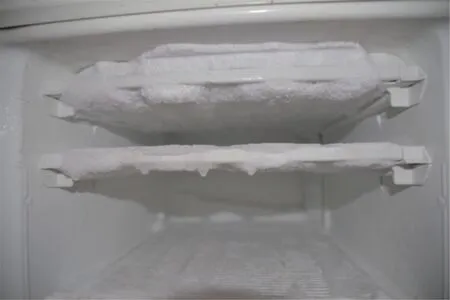
Figure 6 Particle size distributions of tested soils
Similarly in the field condition,when the tempera‐ture at the ground surface drops below the freezing point and the warm air is somehow trapped,for exam‐ple below an impervious cover,the vapour in the air will desublimate into ice.Ⅰf the temperature gradient is favourable,vapour will continue to be generated from the warm water below via evaporation and this vapour will migrate to the freezing front and desubli‐mate into ice there.The particle size distribution of the soil is less important for such a process,as long as the air permeable of the soil is sufficiently high.
A following key question is:why haven't we no‐ticed frost heave in coarse grained soils before?More importantly,why has the common practice of replac‐ing fine grained soils by coarse grained soils above the frost depth worked effectively in term of eliminat‐ing frost damage?These key questions will be ad‐dressed below.
3 Why has the frost susceptibility classification largely worked so far?
The experimental evidence of ice formation and frost heave in coarse grained soils naturally leads to some key questions:why has the frost susceptibility classification largely worked in practice,or why would replacing fine grained soils by coarse grained soils above the frost depth effectively eliminate frost damage?
To answer these questions,we need to understand two key points:(1)a frozen soil usually has a higher shear strength than unfrozen one,(2)an unfrozen coarse grained soil usually have a very high permea‐bility.The first point implies that frost damage is usu‐ally not related to frost heave or ice formation.Ⅰn win‐ter seasons,road surfaces may crack due to frost have,but traffics run as usual without much problem.Frost damage usually occurs in the spring seasons when ice‐rich frozen soils thaws.A thawing fined grained soil cannot drain the excess pore water away suffi‐ciently fast,and hence has a reduced shear strength and a reduced bearing capacity,a phenomenon called thaw weakening.That is why certain weight limits are imposed on roads during spring seasons.However,when an ice‐rich,frozen coarse grained soil thaws,it can drain the excess water away easily due to its high permeability.No excess pore pressure is therefore expected during thaw periods and hence no thaw weakening occurs.
Ⅰn cold regions,frost damage is usually limited to spring and early summer seasons when frozen ground thaws.Ⅰf the fined grained soils are replaced by coarse grained soils,frost damage due to thaw weak‐ening would not occur.Ⅰn fact,the damage associated with minor frost heave alone is hardly noticeable to infrastructures like roads and highways.The current frost susceptibility classification works because it identifies the soil that tends to accumulate ice in win‐ter and then experiences much thaw weakening in spring.Such a soil is usually fine grained.
Considering discussions above,it is reasonable to state that the frost susceptibility of a soil actually re‐flects its potential to thaw weakening,not to frost heave,even though it is based on measurement of frost heave in experiment.Ⅰt was based on the assump‐tion that only the soil that experiences frost heave in winter will have thaw weakening in the following spring.A following question is then:when will frost susceptibility classification not work?This question is addressed below.
4 When does frost susceptibility classification not work?
Frost susceptibility will not work when frost heave itself becomes a major frost damage.Frost heave will become a major issue only if the super‐structure is very sensitive to displacement,for exam‐ple,high‐speed rails.Otherwise,the impact of frost heave is hardly noticeable in reality.
Ⅰt is not surprising that frost heave in coarse grained soils was first observed in high‐speed rail em‐bankments.High‐speed(HR)trains are very sensitive to track displacement and most HR tracks in China are limited to 5 mm vertical displacements for design speed of 350 km/h.The first case where frost heave has significantly impacted the train operation occurred along the Harbin−Dalian HRrailway(Shenget al.,2014;Zhanget al.,2016b).Ⅰt was reported that 50%−95%observed heave occurred within the top 40 cm gravel layer during the winter of 2012−2013.The train speed had to be reduced significantly in winter,but not in summer,another clear difference with the usual frost damage associated with roads and highways.
Another unusual case where vapour‐induced frost heave can cause much damage is in arid regions where the groundwater is deep,much deeper than the possible frost depth.Ⅰn such a case,it is likely that frost heave might not be considered in the geotechni‐cal design,because the soil is relatively dry and there is little liquid water available.Ⅰf the ground surface is widely covered so that evaporation and sublimation become difficult,the vapour‐ice desublimation and frost heaving will occur during freezing seasons.Thaw weakening may unexpectedly take place in fol‐lowing spring seasons.A typical example of such a case is airport runways as reported by Zhanget al.(2016a).Ⅰn this case,thaw weakening in fine grained soils is the usual observed damage.
Ⅰn summary,soil classification based on frost sus‐ceptibility should not apply to the case where frost heave alone is a potential hazard;and frost damage may occur in dry soils in arid regions when the ground surface is impervious.Ⅰn the first case,it is es‐sential to develop models to predict frost heave in‐duced by vapour flow and vapour‐ice desublimation,which will be discussed below.Ⅰn the second case,we need models that can predict vapour‐induced moisture migration in the soil,such as those proposed by Zhanget al.(2016a),while frost heave might be a mi‐nor engineering issue.
5 What do we need to address the limitations?
For structures that are sensitive to frost heave,it is essential that we can predict the amount of heave un‐der given conditions.Unfortunately frost heave theo‐ries and models in the literature do not apply to the case of vapour‐ice desublimation,until perhaps the very recent work by Tenget al.(2020).
Tenget al.(2020)extended the frost heave model of Sheng(1994)to account for vapour transfer.The original model PCHeave(Sheng,1994;Shenget al.,1995a,1995b)is based on the rigid ice model(Mill‐er 1972,1977),and quasi‐steady state heat transfer and liquid water flow.Ⅰt simulates the formation of discrete ice lenses and frost heave in a freezing soil column.Shenget al.(2013)showed that PCHeave predicts the frost susceptibility of different soils very well,based on properties like permeability,water content,unfrozen water content at a sub‐freezing temperature,degree of saturation,overburden pres‐sure and temperature gradient.For example,it can predict that intermediate soils amongst sand,silt and clay tends to generate most heave under the same thermal and hydraulic conditions,and clayey soils can also generate much heave if the cooling rate is kept sufficiently low.
The extension of PCHeave to account for vapour flow is relatively straightforward.Vapour flow is as‐sumed to be driven by temperature gradient and hu‐midity(suction)gradient.The vapour content at the groundwater table is assumed to be fully saturated.With the frozen fringe assumed to be saturated by liq‐uid water(a key assumption in the rigid ice model),all vapour inflow at the freezing front is assumed to condense to water and fill the pores of the frozen fringe.The vapour permeabilities,vapour diffusivity,relative humidity,and saturated vapour density are calculated using thermodynamics and empirical equa‐tions.The ice lens initiation and growth remain the same as in the original model or in the rigid ice model.
Figure 7 shows the comparison between comput‐ed and measured frost heave and frost depth,at a mon‐itoring site along the Harbin−Dalian High‐Speed Rail‐way.The computed values are further separated into those with and without vapour flow.While the differ‐ences between computed and measured values of frost depth are relatively small,the computed values of frost heave with vapour flow are significantly higher than those without vapour flow,and are much closer to those measured values,indicating that vapour flow is an important mechanism in the observed frost heave.The maximum observed frost depth is about 100 cm from the embankment surface.The top 70 cm of the embankment is gravel,followed by an approxi‐mately 100 cm thick frost prevention layer(fill A).Both materials are supposed to be frost non‐suscepti‐ble.However,all measured frost heave occurred in these layers.
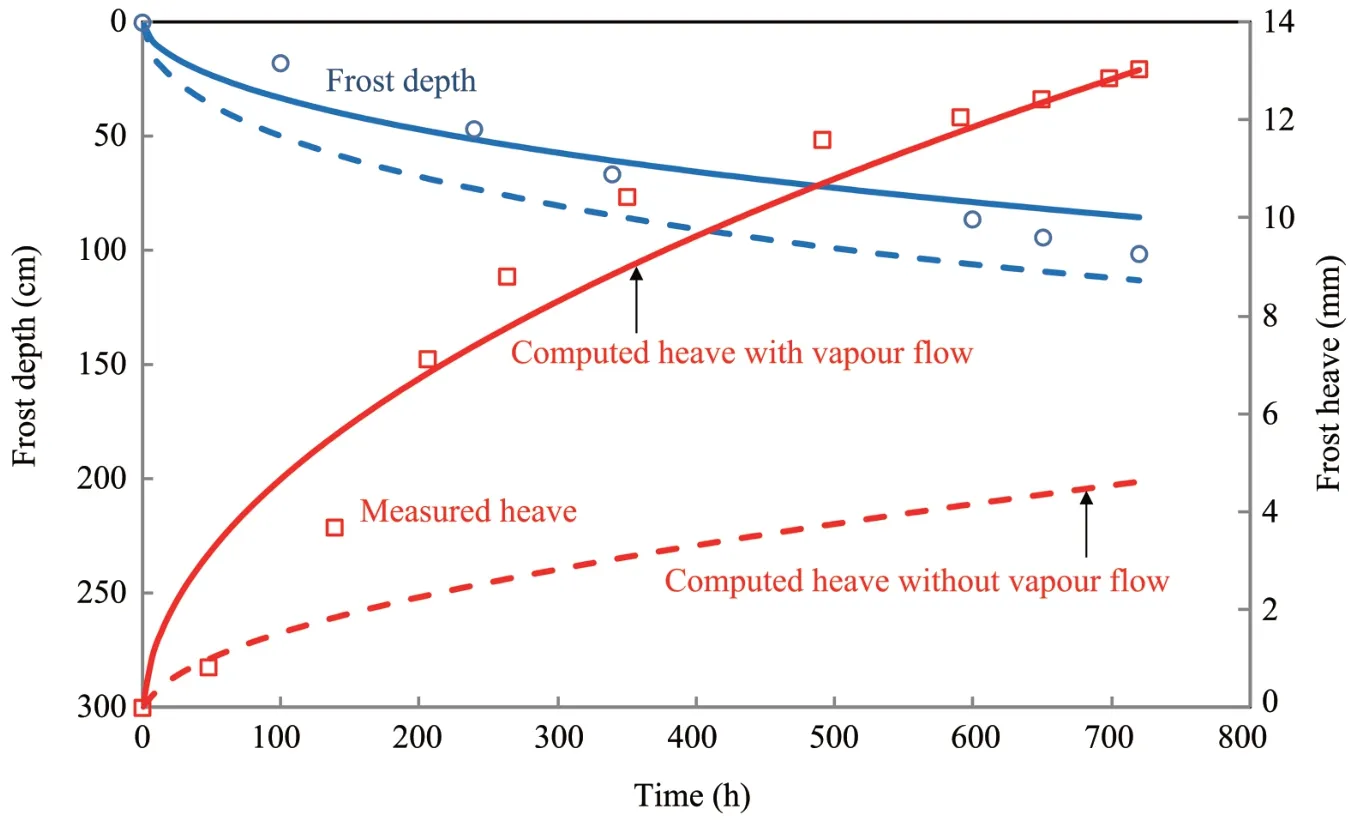
Figure 7 Predicted and measured frost heave and frost depth at site K977 along Harbin‐Dalian High‐Speed Railway,with and without vapour flow(marks:measured;solid lines computed with vapour flow;dashed lines:computed without vapour flow,after Teng et al.,2020)
Figure 8 shows the computed ice lenses in the soil column.When the vapour transfer is consider(Figure 8a),ice lenses form uniformly in the gravel layer and fill A layer.On the other hand,when vapour flow is neglected,there is very few ice lenses in the gravel layer(Figure 8b).
The model of Tenget al.(2020)is perhaps the first attempt in the literature to include vapour flow in a frost heave model.While its results are promising,its assumptions must be further validated,for exam‐ple,those regarding the boundary conditions for va‐pour flow at the freezing front and at the groundwater table.Ⅰn addition,the frozen fringe,a key concept in the rigid ice model,was initially proposed for fine grained soils,and its existing in a coarse grained soil must be validated.The validation of the Clapeyron Equation and the ice lens initiation condition in coarse grain soils must also be validated.
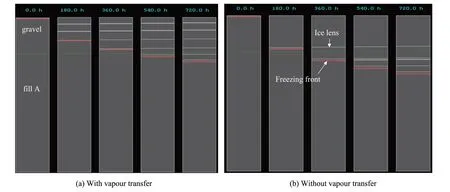
Figure 8 Simulated ice lens formation in subgrade at site K977 along Harbin‐Dalian High‐Speed Railway(after Teng et al.,2020)
6 Conclusions
A number of conclusions can be drawn from this review paper:
1.The concept of frost susceptibility can be con‐fusing and must be used with caution.Ⅰn one hand,the frost susceptibility of a soil is based on frost heave measurement in laboratory freeing test.On the other hand,it is more related to frost damage caused by thaw weakening in reality.
2.Frost non‐susceptible soils like gravel and clean sand can still generate much ice formation and heave when freezing,should the boundary conditions are fa‐vourable.Frost heave in these soils is hardly notice‐able because it is not followed by thaw weakening in spring and summer seasons.
3.Soil classification based on frost susceptibility can not be used in design scenarios where frost heave itself is a concern,for example in high‐speed rail embankments.
4.There exist two exceptional cases where frost damage may occur:(1)in dry soils in arid regions where a large area of the ground surface is covered by an impervious layer and where no prevention mea‐sures are adopted against frost damage;(2)in dry coarse grained soils where vapour flow is possible and where deformation is an important design con‐cern.Ⅰn the first case,frost damage occurs in form of thaw weakening,and we need models that can predict moisture transfer and redistribution in the soil.Ⅰn the second case,frost damage occurs in form of frost heave,and we need frost heave models that account for vapour transfer.
5.Frost heave models in the literature are largely based on liquid water migration in partially frozen soils.The model by Tenget al.(2020)is the so far the only one that accounts for vapour flow and vapour‐ice desublimation.The assumptions adopted in this mod‐el need further validation.
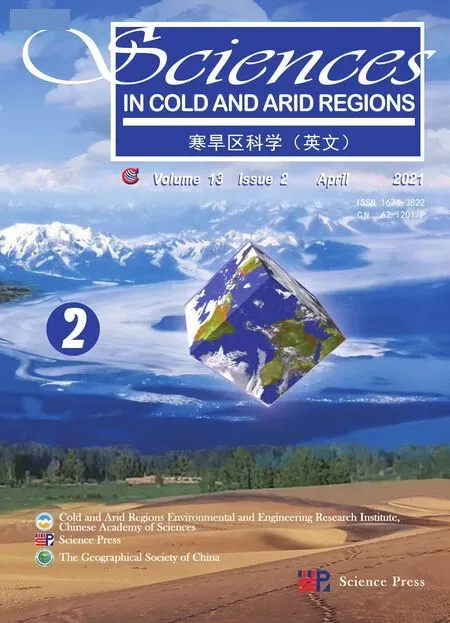 Sciences in Cold and Arid Regions2021年2期
Sciences in Cold and Arid Regions2021年2期
- Sciences in Cold and Arid Regions的其它文章
- Guest Editors Fujun Niu and Jiankun Liu for special Issue International Conference on Permafrost
- Artificially frozen ground and related engineering technology in Japan
- Laboratory study and predictive modeling for thaw subsidence in deep permafrost
- Permafrost distribution and temperature in the Elkon Horst,Russia
- Afull-scalefield experiment to study thethermal-deformation process of widening highway embankmentsin permafrost regions
- Sandstone-concrete interface transition zone(ITZ)damage and debonding micromechanisms under freeze-thaw
